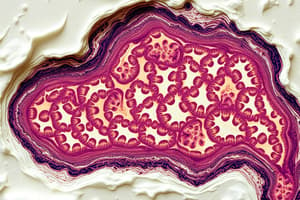Podcast
Questions and Answers
What is the primary purpose of using intraoperative histopathological techniques during surgery?
What is the primary purpose of using intraoperative histopathological techniques during surgery?
- To provide immediate diagnostic information about the tissue sample. (correct)
- To permanently archive the tissue sample for future analysis.
- To prepare the tissue for long-term preservation.
- To identify the presence of antibodies in the tissue.
Which step is essential in the tissue embedding process for histopathological examination?
Which step is essential in the tissue embedding process for histopathological examination?
- Removing excess water from the tissue sample.
- Incorporating a hardening agent to stabilize the embedded tissue. (correct)
- Using a cryostat to create thin sections of the tissue.
- Maintaining the tissue at room temperature during preparation.
Which of the following methods is commonly used for histological staining to differentiate cellular structures?
Which of the following methods is commonly used for histological staining to differentiate cellular structures?
- Decalcification followed by staining.
- Transmission electron microscopy staining.
- Hematoxylin and eosin staining. (correct)
- Fluorescent staining for specific antigens.
What is the primary goal of microscopic sectioning in histopathology?
What is the primary goal of microscopic sectioning in histopathology?
Which technique is primarily used for decalcification of bone tissue before histopathological examination?
Which technique is primarily used for decalcification of bone tissue before histopathological examination?
What is the primary purpose of dehydration in tissue processing?
What is the primary purpose of dehydration in tissue processing?
Which substance is commonly used to clear tissue by replacing alcohol during processing?
Which substance is commonly used to clear tissue by replacing alcohol during processing?
What is the main effect of using an acid during the decalcification process of bone tissue?
What is the main effect of using an acid during the decalcification process of bone tissue?
What is the final step in tissue processing before microscopic examination?
What is the final step in tissue processing before microscopic examination?
Why is it essential to monitor the decalcification process closely?
Why is it essential to monitor the decalcification process closely?
Which statement describes the sectioning step in tissue processing?
Which statement describes the sectioning step in tissue processing?
Which method is NOT typically used in the embedding step of tissue processing?
Which method is NOT typically used in the embedding step of tissue processing?
What role does staining play in the tissue processing sequence?
What role does staining play in the tissue processing sequence?
What happens to a tissue if the dehydration step is skipped during processing?
What happens to a tissue if the dehydration step is skipped during processing?
Which agent is a common chelating agent used for decalcifying bone tissue?
Which agent is a common chelating agent used for decalcifying bone tissue?
What is the primary purpose of tissue fixation in histopathology?
What is the primary purpose of tissue fixation in histopathology?
Which fixative is considered best for routine histology of large tissue specimens?
Which fixative is considered best for routine histology of large tissue specimens?
How are tissue samples typically prepared for microscopic examination?
How are tissue samples typically prepared for microscopic examination?
What characteristic makes glutaraldehyde a preferred fixative for electron microscopy?
What characteristic makes glutaraldehyde a preferred fixative for electron microscopy?
Which of the following statements is true regarding the use of alcohol-based fixatives?
Which of the following statements is true regarding the use of alcohol-based fixatives?
Why is Bouin's Solution particularly suitable for delicate tissues?
Why is Bouin's Solution particularly suitable for delicate tissues?
What is the typical thickness of ultra-thin sections cut from embedded tissue for microscopic examination?
What is the typical thickness of ultra-thin sections cut from embedded tissue for microscopic examination?
What is the role of staining in histopathological examination?
What is the role of staining in histopathological examination?
Which of the following steps occurs first in the intra-laboratory preparation of tissue?
Which of the following steps occurs first in the intra-laboratory preparation of tissue?
What is the purpose of decalcification in tissue preparation?
What is the purpose of decalcification in tissue preparation?
What is the primary purpose of fixation in biopsy preparation?
What is the primary purpose of fixation in biopsy preparation?
Which of the following steps is NOT involved in processing a biopsy?
Which of the following steps is NOT involved in processing a biopsy?
For effective microscopic examination, why is positioning essential before embedding tissue samples?
For effective microscopic examination, why is positioning essential before embedding tissue samples?
How does Hematoxylin function in H&E staining?
How does Hematoxylin function in H&E staining?
What is the main benefit of using Masson's Trichrome staining in liver biopsies?
What is the main benefit of using Masson's Trichrome staining in liver biopsies?
What is the primary purpose of using the frozen section technique during surgery?
What is the primary purpose of using the frozen section technique during surgery?
What is the role of decalcification in preparing bone tissue for histological examination?
What is the role of decalcification in preparing bone tissue for histological examination?
Which machine is used for rapidly freezing tissue samples in the frozen section technique?
Which machine is used for rapidly freezing tissue samples in the frozen section technique?
Which stain would you use to visualize glycogen storage diseases in tissue?
Which stain would you use to visualize glycogen storage diseases in tissue?
What potential limitation of the frozen section technique is mentioned?
What potential limitation of the frozen section technique is mentioned?
What common mistake may occur during the sectioning of embedded biopsies?
What common mistake may occur during the sectioning of embedded biopsies?
What is the purpose of staining the tissue slices with dyes like Hematoxylin and Eosin?
What is the purpose of staining the tissue slices with dyes like Hematoxylin and Eosin?
During the microscopic examination, what determines whether a surgeon decides to remove more tissue?
During the microscopic examination, what determines whether a surgeon decides to remove more tissue?
Which step in the frozen section process immediately follows sectioning the frozen tissue?
Which step in the frozen section process immediately follows sectioning the frozen tissue?
What differentiates the frozen section technique from regular post-operative tissue processing?
What differentiates the frozen section technique from regular post-operative tissue processing?
What type of examination follows the staining of tissue slices?
What type of examination follows the staining of tissue slices?
Why might a surgeon opt to remove more tissue based on frozen section results?
Why might a surgeon opt to remove more tissue based on frozen section results?
Which of the following statements about decalcification techniques is true regarding frozen sections?
Which of the following statements about decalcification techniques is true regarding frozen sections?
Flashcards are hidden until you start studying
Study Notes
Pre-laboratory and Intra-laboratory Tissue Preparation
- Tissue samples are collected during surgical procedures (biopsies, resections), or through autopsies.
- Proper specimen identification, labeling, and documentation is crucial for accurate analysis.
- Tissue preservation is essential, achieved by placing samples in appropriate media or fixatives to prevent degradation.
Intra-laboratory Tissue Handling and Preparation
- Trimming: Tissue is resized to fit processing requirements.
- Fixation: Stabilization of tissue is crucial to prevent self-destruction (autolysis) and bacterial decomposition.
- Processing: Tissues are dehydrated, cleared, and embedded for sectioning.
- Embedding: Tissue is placed in a solid medium, typically paraffin wax, to facilitate slicing.
- Sectioning: Thin tissue slices (3-5 µm thick) are prepared for microscopic examination.
- Staining: Different stains are used to highlight specific cell structures or tissue components.
Fixation of Tissue Material
- Fixation is essential for preserving tissue morphology and preventing degradation.
- Formaldehyde (Formalin): Commonly used fixative, maintaining cellular structure and proteins.
- Glutaraldehyde: Primarily used for electron microscopy, excellent for ultrastructural preservation.
- Alcohol-based Fixatives: Used for cytology and smears, quickly fix cytological specimens.
- Bouin’s Solution: Suitable for delicate tissues like biopsies, preserving soft tissue well.
Suitable Fixative Selection for Tissue
- Formalin: Best for routine histology on large tissue specimens.
- Glutaraldehyde: Preferred for electron microscopy.
- Alcohol-based Fixatives: Used for cytological samples like pap smears and fine needle aspiration (FNA) samples.
- Bouin's Solution: Used for delicate tissue like endocrine organs.
Bone Preparation
- Bone tissue requires specific preparation due to its hardness.
- Decalcification: Calcium removal from bone is crucial before sectioning.
- Decalcification process involves soaking bone in acidic solutions or chelating agents to soften the bone.
- Timing of decalcification varies based on bone size and solution used, and careful monitoring is essential to avoid damaging the tissue.
- Trimming: Once decalcified, the bone is trimmed to a manageable size for processing and embedding.
- Embedding: Following trimming, the bone undergoes dehydration, clearing, and embedding in paraffin wax, enabling sectioning.
Biopsy Preparation
- Biopsies are small tissue samples from suspicious areas like skin, liver, or tumors.
- Handling biopsies carefully is crucial to preserve their intricate structures.
- Fixation is similar to other tissues, typically involving formalin to prevent degradation.
- Processing follows the same steps as other tissues, including dehydration, clearing, and embedding in paraffin.
- Sectioning of the embedded biopsy allows for microscopic examination.
Orientation and Positioning
- Both bone and biopsy samples require careful positioning before embedding.
- Positioning ensures that the most informative areas are available for examination.
Staining
- Staining is a crucial step for visualizing cellular and tissue structures under a microscope.
- Hematoxylin and Eosin (H&E Staining): Standard stain for general tissue morphology.
- Hematoxylin stains nuclei blue/purple.
- Eosin stains cytoplasm and extracellular matrix pink/red.
- Periodic Acid-Schiff (PAS Staining): Highlights carbohydrates (e.g., glycogen, mucins) in tissues.
- Masson's Trichrome: Differentiates between muscle fibres (red), collagen (blue/green), and nuclei (black).
- Immunohistochemistry (IHC): Uses antibodies to target specific antigens for accurate identification of cell types, proteins, and receptors.
Frozen Section Technique
- This rapid technique provides immediate information about a tissue sample during surgery.
- Tissue is quickly frozen, sectioned, stained, and analyzed by the pathologist, guiding surgical decisions.
- Freezing makes the tissue hard enough for cutting thin slices.
- Thin slices of frozen tissue are cut using a cryostat (a special freezing microtome).
- Stained with dyes (like Hematoxylin and Eosin) for microscopic examination.
- Pathologists examine the tissue to provide information to the surgeon.
Advantages of Frozen Section Technique
- Immediate Diagnosis: Helps surgeons make crucial decisions during surgery.
- Saves Time: Eliminates the need for additional surgeries by confirming diagnoses or treatment options immediately.
Limitations of Frozen Section Technique
- Less detailed: Frozen sections may not be as detailed as regular (postoperative) tissue processing due to potential tissue distortion.
- Not suitable for all tissues: Certain tissues, like fatty tissues, may not freeze well and can be challenging to analyze.
Overview of Histopathological Techniques
- Histopathology is the study of diseased tissues using a microscope to diagnose diseases based on tissue architecture and cellular details.
- Pathologists examine tissues to identify abnormalities and provide critical information for diagnosis and treatment decisions.
Types of Histopathological Procedures
- Intraoperative (Frozen Section): Performed during surgery for immediate diagnosis.
- Postoperative (Routine Histology): Detailed analysis of tissue samples after surgery.
- Autopsy: Examination of tissues after death to determine the cause of death.
Studying That Suits You
Use AI to generate personalized quizzes and flashcards to suit your learning preferences.




